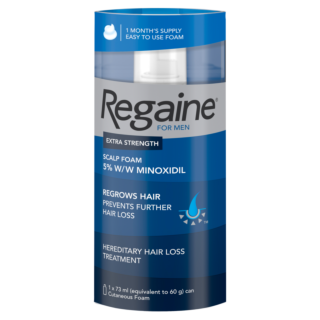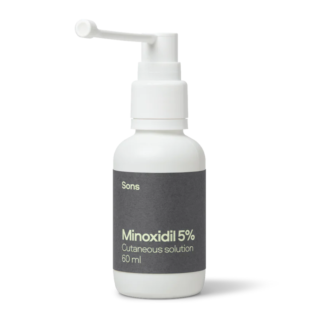Everything you need to know about hair loss: causes, prevention & treatments that actually work!

There are many causes of hair loss, such as menopause, alopecia, genetics, stress, scalp conditions and medications.
It can develop slowly over a few years, or it can happen abruptly. Depending on the cause, it can either be temporary or permanent.
Hair loss and hair thinning can be upsetting, however, more people suffer from hair loss than you might think. There are ways you can prevent it from happening in the first place and ways you can also treat it.
This guide will tell you everything you need to know about hair loss, at-home treatments and surgical options such as hair transplants…
How can I tell if I’m losing my hair?
There are a few ways to tell if you’re beginning to lose your hair. When you’re parting your hair, you might notice that your parting is getting wider, or you might find bald patches.
A receding hairline is also another common sign that you’re losing hair. If your hairline is higher than usual then this may be a sign of thinning hair.
Checking your hair brush and drains can also give you an idea if you’re losing hair. If you notice excess hair on your brush after brushing, it could be a sign that you’re losing hair. If you find more hair than usual in your drains, this is also a sign that you might be experiencing hair loss.
How much hair loss is bad?
It’s normal for the average person to lose between 50 to 100 strands of hair per day[1]
You can perform a test at home called the “pull test” to see how much hair you’re losing. You should run your fingers through your hair, tugging gently when you get to the end. No more than 10 hairs per 100 strands should be coming out.
Is hair loss different in men and women?
Whilst both men and women can experience losing their hair, it tends to be more noticeable and common in men.
Hair loss in men
The most common type of hair loss in men is male pattern baldness. It usually develops slowly, starting with a receding hairline or a bald spot on the top of the head.
In men, it can be triggered by genes passed down to you from your parents. Depending on your family history, it can start as early as your teenage years.
It’s a common misconception that high testosterone can cause hair thinning or loss; this isn’t true and won’t lead to baldness.

Hair loss in women
Many people think that loosing hair only affects men, however, this isn’t true! Research has shown that more than 50% of women will experience hair loss at some point in their life.[2]
The most common cause of hair loss in women is female pattern hair loss.
Women might experience postpartum hair loss after having a baby or thinning associated with menopause.
What are the causes of hair loss?
There are many causes of hair loss and thinning hair, and they can vary from person to person.
Male and female pattern baldness is permanent. This is something that is usually passed down to you genetically.
Other types of hair loss might be temporary. This may be caused by an illness, stress, cancer treatment, iron deficiency, medical conditions and weight loss.
How stress causes hair loss
Emotional stress can lead to a change in your mood. These mood changes can trigger hormonal imbalances, which can lead to you losing hair.
Stress can also push a large amount of your hair follicles into a phase where they stop growing. After a couple of months, this will cause your hair to fall out. You might begin to see noticeable amounts of hair when you’re brushing your hair.
Does losing weight cause hair loss?
Weight loss causes hair loss, but not always. If you have lost weight from surgery or restrictive dieting this can put stress on your body.
You might also find that nutrient deficiencies that come from extreme dieting can contribute to hair loss.
Hair loss from alopecia
Alopecia is an autoimmune disease. It usually causes your hair to fall out in patches which are typically small and round. Sometimes you might experience it falling out in smaller or bigger patches.
In some cases, alopecia can lead to you experiencing loosing your hair on a greater level. It might be more significant, including complete loss of hair.
What scalp conditions cause hair loss?
Some scalp conditions can lead to you loosing your hair. Fungus, psoriasis and dandruff (seborrheic dermatitis) are the main conditions that are known to cause effect your hair.
The most common fungal infection that can affect the hair is ringworm. It requires you to take an antifungal medication to get rid of it.
Seborrheic dermatitis makes your scalp shed. Although dandruff itself doesn’t cause you to directly lose your hair, it can cause you to scratch your scalp and injure it. Repeat inflammation in the hair follicles can cause damage.

Can a lack of B12 cause hair loss?
Vitamin B12 is necessary to maintain hair growth. If you’re not getting enough vitamin B12 in your diet then you’re putting yourself at risk of hair thinning.
The vitamin helps to make red blood cells that carry oxygen to your hair follicles. When your vitamin B12 levels are low, your hair follicles may not be able to grow new hair efficiently.
Having a vitamin B12 deficiency can also lead to symptoms of anaemia. Anaemia is linked to low iron levels, hair thinning and loss.
Do you lose hair during menopause?
Some women will experience loosing hair during menopause. Menopause hair loss is likely to happen to 40% of women. [3]
Ageing and a lack of oestrogen are usually the culprits during menopause. As you get older, the hair follicles start to shrink, causing your hair to become thinner. Your hormone levels are changing, including your oestrogen levels. It’s thought that oestrogen helps to support hair growth.
Is creatine linked to hair loss?
If you’re into sports and you take regular supplements, you might want to know if creatine can cause hair loss. Creatine is a supplement that’s used by athletes to improve sports performance and increase muscle mass.
When you’re using the supplement, it can lead to increased levels of the hormone dihydrotestosterone (DHT). DHT alters your hair growth cycles by accelerating the process. By quickening the cycle of the hair follicles, it can lead to them falling out.
Which medicines cause hair loss?
Some types of medical treatments can cause you to lose your hair. The most common types of medication that can cause this are:
- Acne medications
- Antibiotics
- Antifungals
- Anticoagulant drugs
- Cholesterol-lowering drugs
- Immunosuppressants
- Anticonvulsants
- Beta-blockers
- Antidepressants and mood stabilisers
- Weight loss drugs
- Medication for gout
- Chemotherapy
How does smoking stunt hair regrowth and cause hair loss?
Smoking can cause you to lose hair in several ways. From reducing blood flow to your scalp or causing damage to the DNA of your hair follicles, if you’re a smoker, you’re at a higher risk of experiencing loss of hair.
With a reduction of blood flow to the scalp, trying to get your hair to regrow when you’re a smoker is difficult. Your hair is open to damage as a smoker. Each time you smoke, the cigarette fumes surround your hair. Your hair can soak up the fumes, leading to damage.
If you’re a smoker, you should consider quitting smoking.

What is the best treatment for hair loss?
Regaine For Men
Regaine For Men is a solution for loss of hair and thinning in men. It encourages blood flow to your scalp and hair follicles. It’s designed to help your hair grow back and provides you with the essential nutrients your hair needs.
Regaine For Men is a lengthy process. You will need to use the treatment twice a day, each day for at least two months before you see noticeable changes.
Sons Minoxidil
Sons Minoxidil is another way you can treat loosing your hair. It’s recommended for men with mild hair loss who are experiencing early signs of a receding hairline or loosing hair in the crown area.
The active ingredient in this product is minoxidil which is a known vasodilator. It works by expanding the blood vessels in the scalp and improving blood flow to the area.
Minoxidil for hair loss is generally well tolerated, however, it’s important to remember that like all products, minoxidil has side effects that you should be aware of before use.
Propecia
Propecia is a prescription-only medication that can help to increase hair growth and prevent further loss. It’s a tablet that you only need to take once a day, making it easy to fit into your daily schedule.
The tablet works by reducing the levels of DHT in your scalp to help reverse the balding process, leaving you with thicker hair.
Alpecin Double Effect Caffeine Shampoo
Alpecin Double Effect Caffeine Shampoo uses the stimulating properties of caffeine. It energises the scalp and promotes healthy hair growth.
The shampoo also contains zinc and niacin which are known to support natural hair growth.
How to prevent hair loss
Don’t brush your hair while wet
Brushing your hair when it’s wet can be damaging. When your hair is wet, it’s in its most fragile state. You should either let your hair air dry or use a hairdryer before brushing it to prevent breakage.
If you must brush your hair when it’s wet then don’t use a regular brush. You should use a brush that has been specifically designed for detangling wet hair.
Be gentle with your hair
When it comes to brushing your hair, you should start at the end of your hair and work your way up to the top to untangle it.
It’s important that you are as gentle as possible with your hair to prevent unwanted breakage.
Chose a soft brush with natural fibres
Using a hair brush that is made of natural fibre bristles is a lot kinder to your hair and scalp. It tackles knots more easily and can decrease the amount of hair you lose due to tugging at your tangles.
By opting for a brush with natural fibres, it will also help to stimulate blood flow.
Wear your hair down
You should also be gentle with your styling. Avoid tight braids or ponytails that might pull on your hair. These types of hairstyles can potentially lead to excess shedding.
Try and wear your hair down as often as you can to reduce breakage. Leaving your hair down can also promote growth by allowing it to move more freely and naturally. This can stimulate the blood flow to your scalp, promoting healthy hair growth.
Invest in silk or soft cotton pillowcases
Regular cotton pillowcases generate a lot of friction, which can cause your hair to get tangled and snap more easily.
Choosing a silk pillowcase will allow your hair to move around the surface of the pillowcase without getting as knotted, reducing the chances of breakage.
Eat healthier foods
Not only does eating healthier foods reduce your chance of weight gain, a healthy diet can reduce your risk of loosing hair, too.
Foods such as eggs, berries, spinach, avocados, nuts, beans, and meat can all help with hair growth and maintaining healthy hair.
Eating a healthy, balanced diet is important when it comes to supporting hair growth and preventing loss. There’s not one specific food group that best supports your hair; that’s why a balanced diet is so important.

Is it ever too late to stop hair loss?
It’s never too late to address loosing your hair or to try and stop it. It doesn’t matter what stage you’re dealing with, there’s things you can do to stop or slow it down.
With several non-invasive treatments, there will always be options when it comes to saving your thinning hair.









